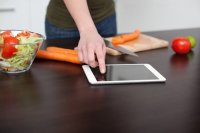6 Free iPad Apps for Making Healthy Choices
Back to school is the perfect time of year to establish routines and remind students about making healthy choices. Children of all ages should have an understanding of the impact of their decisions related to the food they choose to eat. There are a variety of games and resources to promote discussions about healthy eating and to help students make smart choices.
Fooducate
I love using QR codes in my classroom, but barcodes can be helpful, too. Grab a cereal box, bag of chips, or any food with a barcode. Fooducate lets users scan the barcode of any a processed food item. Each product is given a letter grade based on how healthy that food item is -- and provides details to support its claim. This interactive app can be used with almost any food product that can be scanned at a supermarket checkout. Whether you're taking your students on a community field trip or creating a virtual grocery store in your classroom, Fooducate is a great app for sparking conversation. This app is perfect for teaching students how to shop smart, choose healthy foods, and even think about the way products are marketed.
Big Fork Little Fork
With lots of options to choose from, Big Fork Little Fork is a free app that packs a punch. Share tips on cooking, good nutrition and produce, and learn skills that can be used to maintain a healthy lifestyle. This app includes how-to videos and games that explore the food pyramid.
Awesome Eats
Get your students excited about nutrition with a game that promotes healthy eating. Awesome Eats from Whole Foods has a fantastic free app that is addictive and informative. Players must identify different healthy foods as they appear on a conveyer belt. They need to organize each fruit and vegetable into different baskets in order to earn points. In between each level, children are given tips about how to make healthy choices. Have your students create a list of new foods they have learned, and collect new facts to share with their families and classmates.
Eat-And-Move-O-Matic
The idea of caloric intake might be hard for students to appreciate, but Eat-And-Move-O-Matic is a wonderful app that illustrates this concept perfectly. By manipulating two dials, students can see exactly how many calories are in common food choices and how much exercise they would need to burn off those calories. The amount of time they'll have to spend swimming or running to burn the calories consumed will change based on the food they choose. What better way to bring this important idea to life than easy-to-understand cartoon illustrations in a free app that's simple yet powerful!
Seafood Watch
Sustainability is a critical topic for children of all ages to comprehend. The Seafood Watch app is a powerful tool that helps consumers make choices on what type of fish they should purchase at the supermarket or order in a restaurant. An easy search function lets users view what seafood populations are threatened and which fish are "ocean-friendly" choices. It's a great app for demonstrating how one person's decision about what he or she eats can impact the community and the world.
What are some of the ways you teach children how to make healthy choices? Do you have any favorite free apps for promoting exercise and good nutrition in your classroom? Share your resources in the comments section below.
